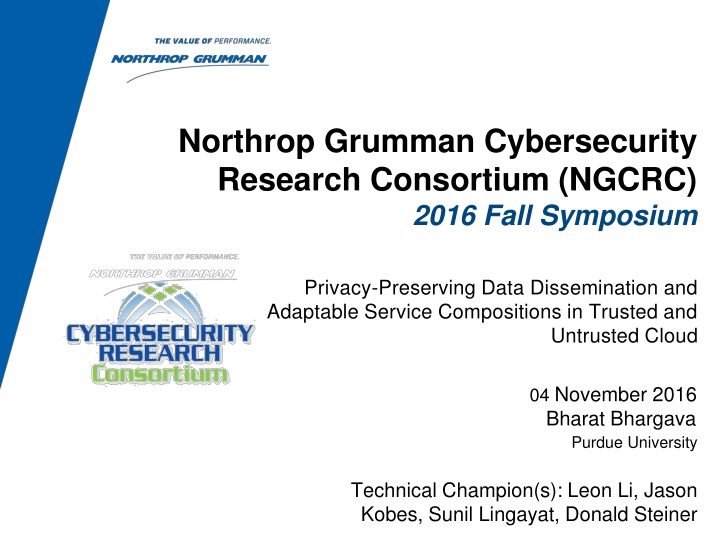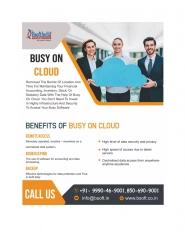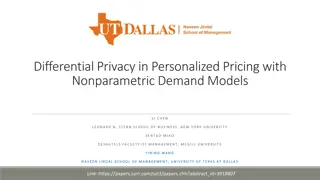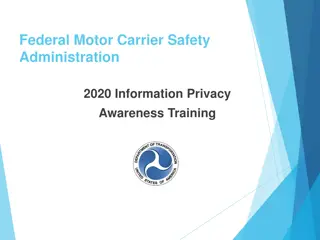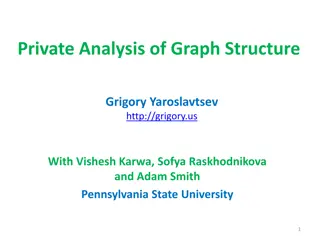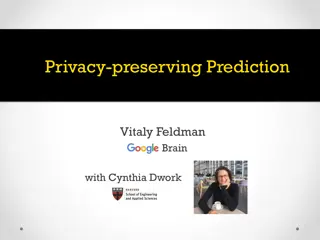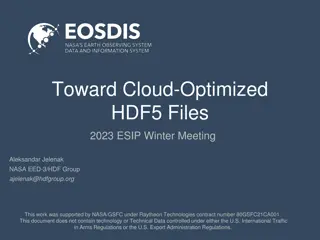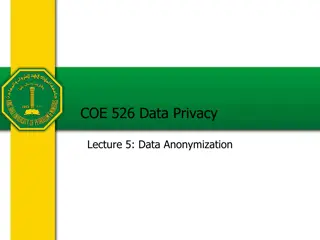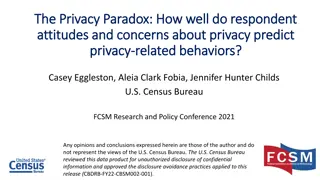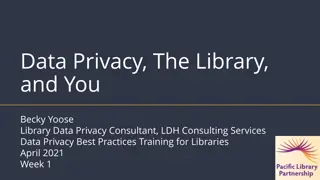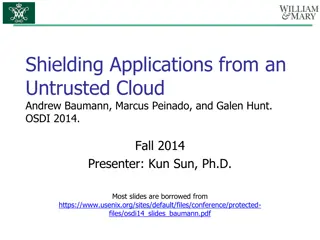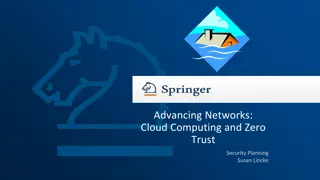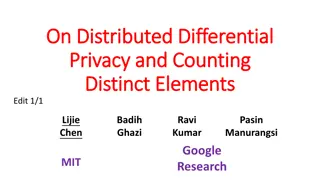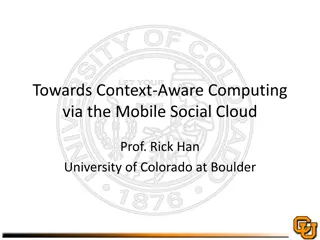Privacy-Preserving Data Dissemination in Trusted Cloud
Northrop Grumman Cybersecurity Research Consortium (NGCRC) focused on secure data dissemination in the cloud, emphasizing authorization and cryptographic capabilities of client browsers. The research proposed adaptable service compositions and highlighted benefits such as context-based dissemination and support for different authentication methods.
Download Presentation

Please find below an Image/Link to download the presentation.
The content on the website is provided AS IS for your information and personal use only. It may not be sold, licensed, or shared on other websites without obtaining consent from the author.If you encounter any issues during the download, it is possible that the publisher has removed the file from their server.
You are allowed to download the files provided on this website for personal or commercial use, subject to the condition that they are used lawfully. All files are the property of their respective owners.
The content on the website is provided AS IS for your information and personal use only. It may not be sold, licensed, or shared on other websites without obtaining consent from the author.
E N D
Presentation Transcript
Northrop Grumman Cybersecurity Research Consortium (NGCRC) 2016 Fall Symposium Privacy-Preserving Data Dissemination and Adaptable Service Compositions in Trusted and Untrusted Cloud 04 November 2016 Bharat Bhargava Purdue University Technical Champion(s): Leon Li, Jason Kobes, Sunil Lingayat, Donald Steiner
COLLABORATION WITH NGC WaxedPrune Project: Web-based Access to Encrypted Data - Processing in Untrusted Environments Researchers at NGC Leon Li Donald Steiner Sunil Lingayat Jason C Kobes
COLLABORATION WITH NGC Weekly meetings to: Advance research based on vision of Donald Steiner, Leon Li, Jason Kobes Install and configure software at MIT side Integrate work with MIT (Harry Halpin) Researchers at Purdue Bharat Bhargava Denis Ulybyshev Pelin Angin Miguel Villarreal Byungchan An Rohit Ranchal Tim Vincent Leszek Lilien
Outline Problem Statement Benefits of Proposed Research Prototype Demo Impact State of the Art Year 7 (2015-2016) Final Report Methodology Results Year 8 (2016-2017) Proposal 4
Problem Statement Focus: Secure Data Dissemination in Cloud Authorized service can only access data items for which it is authorized Unauthorized service denied Provide data dissemination based on cryptographic capabilities of client s browser and authentication methods Support different authentication methods for client service *Adaptable service compositions in cloud 5
Benefits of Proposed Research Independent of data owner's (source) availability Dissemination is based on access control policies and client's attributes: Browser s cryptographic capabilities Authentication method (password- vs. hardware-based vs. fingerprint) Source network (corporate vs. unknown) Type of the device (mobile vs. desktop) Trust level (is continuously monitored) Context-based dissemination supported Different authentication methods supported Ability to operate in untrusted environments Reduced host liability for data 6
Applications and Demonstration of Prototypes Electronic Health Records (EHRs) dissemination in untrusted cloud Dynamic service composition and trust management 7
Prototype for TechFest16: Electronic Health Record Dissemination in Cloud Data Owner Active Bundle Cloud Server Active Bundle Authorized Info for Doctor Authorized Info for Insurance Web Crypto Authentication Authorized Info for Researcher Web Crypto Authentication MIT: Web Crypto Authentication Researcher Doctor Insurance Scenario of EHR Dissemination in Cloud (by Dr. Leon Li, NGC) 8
Impact Comprehensive security and privacy auditing and enforcement architecture for trusted and untrusted cloud Privacy-preserving data sharing approach for client-to- service and service-to-service interactions Independence of data owner's (source) availability Continuous monitoring of SLA and policy compliance Swift detection of failures and attacks in the system Efficient mechanism to dynamically reconfigure service composition based on the system context/state (failed, attacked, compromised) and resiliency requirements Resilient architecture to ensure continuous service availability under failures and attacks Compatible with industry-standard SOA/cloud frameworks 9
State of the Art EnCoRe: Sticky policies to manage privacy of shared data across domains Prone to TTP related issues Sticky policies vulnerable to attacks from malicious recipients DataSafe: Software-hardware architecture supporting confidentiality throughout data lifecycle Require special architecture limited to well-known hosts CloudWatch: Coarse-grain monitoring capabilities of industry- standard cloud systems (such as Amazon EC2) Splunk (log management and analysis tool), GrayLog, Kibana provide storage, search and analysis of big data, but require human intelligence for detection and action for resiliency 10
2015/2016 Methodology AUTHENTICATED CLIENT Browser s Crypto Level: High Authentication Method: Fingerprint Client s device: Desktop Source network: Corporate Intranet AB ACCESSIBLE DATA AUTHENTICATED CLIENT Browser s Crypto Level: Low Authentication Method: Password Client s device: Mobile Source network: Unknown AB INACCESSIBLE DATA ACCESSIBLE DATA INACCESSIBLE DATA 11
2015/2016 Methodology Redirect unauthenticated client s request from Cloud Provider to Authentication Server (AS) Selective Data dissemination based on: Role-based access control policies Security level of client s browser (crypto capabilities) Authentication method (password-based, fingerprint etc) Source network (secure intranet vs. unknown network) Type of client s device: desktop vs. mobile (detected by Authentication Server) 12
Active Bundle Solution Components Sensitive data - Encrypted data items, each value encrypted with its own key: { ab.patientPhone : Enc(1234567890) } Metadata - Access control and operational policies Virtual Machine (Policy Enforcement Engine) - Protection mechanism (self-integrity check) - Policy evaluation, enforcement; data dissemination Policy Enforcement Engine Enc( Sensitive Data) Policies ACTIVE BUNDLE IMPLEMENTATION Executable JAR file Apache-thrift based API JSON-based policies WSO2 Balana-based policy engine Node.js-based SOA architecture 13
Data Dissemination and Leakage Detection in Untrusted Cloud Data (D) = {d1,..,dn} Access Control Policies (P) = {p1,..,pk} TRUSTED DOMAIN D D, P Service 2 forwards D and P to other cloud CLOUD PROVIDER 2 D, P CLOUD PROVIDER 1 D, P ` Data Leaks ? D, P D, P D, P UNKNOWN DOMAIN SERVICE 1 d1 SERVICE 3 d3 SERVICE 2 d2 Authentication of User s Device and Browser for Data Access in Untrusted Cloud, D. Ulybyshev, B. Bhargava, L. Li, J. Kobes, D. Steiner, H. Halpin, B. An, M. Villarreal, R. Ranchal. CERIAS Security Symposium, April 2016. * This work is used in PhD Thesis Proposal of Denis Ulybyshev, Purdue University 14
Key Generation during AB Creation Aggregation{di} ( - Generated AB modules execution info; - Digest(AB Modules), - Resources: authentication code + certificate, authorization code, applicable policies with evaluation code) Ki Key Derivation Module (javax.crypto SecetKeyFactory) ENCki (di) AB Template is used to generate new ABs with data and policies (specified by data owner) Template includes implementation of invariant parts (monitor) and placeholders for customized parts (data and policies) Template is executed to simulate interaction between AB and service requesting access to each data item of AB 15
Key Derivation during AB Execution Aggregation{di} ( - Generated AB modules execution info; - Digest(AB Modules), - Resources) Ki Key Derivation Module (javax.crypto SecetKeyFactory) DECki (di) AB receives access request to data item from service AB authenticates the service and authorizes its request If any module fails (i.e. service is not authentic or the request is not authorized) or is tampered: derived decryption key Ki is incorrect => data is not decrypted "Cross-Domain Data Dissemination and Policy Enforcement", R. Ranchal, PhD Thesis, Purdue University, Jun. 2015. 16
Key Management in AB Key is not stored inside AB Separate symmetric key is used for each separate data value Ensure protection against tampering attacks (discussed with Jason Kobes) di Aggregation{di} (Execution info; Digest(AB Modules); Resources) Ki Key DECki (di) Derivation Module Aggregation{di} ( Tampered ( Execution info; Digest(AB Modules); Resources) ) wrong di K i Key DECk i (di) Derivation Module 17
TechFest16 Demo: Electronic Health Record Dissemination in Cloud Active Bundle: Contact, Medical and Billing Information Hospital (NodeJS Server) Researcher - E(Contact Info) - Medical Info - Billing Info Insurance - Contact Info - E(Medical Info) - Billing Info Doctor - Contact Info - Medical Info - Billing Info (4) (2) (10) (1) (9) (3) (5) (1) HTTP GET Request (2) Hospital s Web Page (3) HTTP POST with Data Request and Role (4) HTTP 302 with AB Request and Role (5) HTTP Get Request (6) AS Web Page (7) HTTP POST with Credentials (8) HTTP 302 with Ticket (9) HTTP Get Request with Ticket (10) Data provided by AB (6) Client (Browser) Authentication Server (7) (8) 18
Authentication Ticket Creation and Validation Authentication Server: Knows shared secret K and Private Key PrivKey Ticket_Info = (Auth_Level, Expiration_Time, Client_ID, Client_Role, Request_Field) Enc_Ticket_Info = EncAES256K(Ticket_Info) Ticket_Signature = EncPrivKey(SHA512(Enc_Ticket_Info)) Ticket = <Enc_Ticket_Info, Ticket_Signature> Doctor, Insurance or Researcher Service: Knows shared secret K and Public Key PubKey Receives Ticket = <Enc_Ticket_Info, Ticket_Signature> Checks: DecPubKey(Ticket_Signature) = SHA512(Enc_Ticket_Info) Gets data: DecAES256K(Enc_Ticket_Info) Doctor is authorized for Contact, Medical and Billing Info of either only her own patients or her own and other doctor s patients Clients are directed to the corresponding services according to their role (researcher, insurance or doctor) Authorization level (included in ticket) and role define the data accessible by requester 19
Scenario 2: Electronic Health Record Dissemination in Cloud Cloud Server Cloud Server Insurance Company Forwards AB to Researcher Active Bundle Active Bundle Active Bundle Doctor Authorized Information for Insurance Company Web Crypto Authentication Web Crypto Authentication Authorized Information for Researcher Insurance Company Researcher Scenario of EHR Dissemination in Cloud (by Dr. Leon Li, NGC) 20
2015/2016 Results Overview Prototype for EHR dissemination in cloud (collaboration with W3C/MIT) Demonstrated at TechFest 2016 Privacy-Preserving Data Dissemination and Data Leakage Detection in SOA , D. Ulybyshev, B. Bhargava, L. Li, D. Steiner, J. Kobes, H. Halpin, M. Villarreal and R. Ranchal. Submitted for ICDE-2017 Authentication of User s Device and Browser for Data Access in Untrusted Cloud, D. Ulybyshev, B. Bhargava, L. Li, J. Kobes, D. Steiner, H. Halpin, B. An, M. Villarreal, R. Ranchal. CERIAS Security Symposium, April 2016. "Cross-Domain Data Dissemination and Policy Enforcement", R. Ranchal, PhD Thesis, Purdue University, June 2015. End-to-End Security in Service-Oriented Architecture, Mehdi Azarmi. PhD Thesis, Purdue University, April 2016. 21
TechFest16 Scenario: Data Available for Doctor Doctor can access Contact, Medical and Billing Info of a patient 22
TechFest16 Scenario: Data Available for Insurance Insurance can get access to Contact and Billing Info of a patient (not to Medical) 23
TechFest16 Scenario: Client Authentication Password-based authentication of a client at Authentication Server 24
Focus: Adaptable Service Compositions in Cloud Need systematic monitoring of service operations and data dissemination for: Resiliency (withstand cyber-attacks, sustain and recover critical function) Antifragility (increase in resilience and robustness as a result of failures) Adaptability (swiftly adapt to changes in context, choose services in orchestration to comply with QoS requirements) 25
System Overview Central Monitor * * * Data dissemination with Active Bundle AB logs Service 1 Monitor A + Log Service 2 Analysis Active Bundle Intelligence Feeds Service 3 Active Bundle Log Listener Monitor B * Service 4 Service State Listener + Threat Analysis Log * Analysis Service 5 * * * Service Monitor C Service 6 + Service Trust Management Reconfiguration Log Service 7 Analysis Service 8 *: service performance & security parameter values +: summary service health data 26
Core Technology & Benefits A novel distributed monitoring tool to: Audit and detect service behavior and performance changes* Gather service trust data and share them securely in various domains Dynamically reconfigure service orchestrations based on security context and QoS requirements** A secure and adaptable data dissemination technology to deal with: Context changes (e.g. crypto capabilities of web browser, user location/device), Trust Sharing policies of data owner System modules for service anomaly detection, service performance monitoring and trust management can be easily integrated into NGC cybersecurity software. The modular architecture and use of standard software in the monitoring framework allows for easy plugin to any system. * A Distributed Monitoring and Reconfiguration Approach for Adaptive Network Computing, Bharat Bhargava, Pelin Angin, Rohit Ranchal, Sunil Lingayat. DNCMS in conjunction with SRDS 2015 (Best paper award) ** End-to-End Security in Service-Oriented Architecture, Mehdi Azarmi. PhD Thesis, Purdue University, April 2016. 27
Service Monitoring / Anomaly Detection System Details Service 1 Anomaly Training/Detection Module Request Interceptors / Performance Monitor HMM Service 2 One-class SVM K-means clustering Other learning algorithms Service 3 EM Service 4 Analysis results Interaction/ performance data stream Local monitor DB Central Monitor 28
Core Machine Learning Technique Used for Service Anomaly Detection in System Model training parameters used: Parameter Cloud services Cloud data services No class labels needed for training. Training data: input vectors without any corresponding target values Unsupervised learning with security and performance parameters used to find clusters Values outside clusters will be detected as outliers and help detection of anomalies. Algorithms: K-means clustering, one class support vector machines (SVM) 29 Number of requests/sec X Bytes downloaded/sec X X Bytes uploaded/sec X X Total error rate X CPU utilization X Memory utilization X Number of authentication failures X Number of connections X Number of connection failures X Number of disk reads/writes X X Network latency X Service response time X Disk space usage X X Throughput X Number of database connections X X Service/cluster health status X
Dynamic Service Composition Experiments Experiment settings: Overhead evalution for three cases: Different number of service categories in composition Different number of services to choose from for each category Different number of QoS contraints Composition time not affected significantly by the number of QoS constraints. Number of services and service categories have more visible effect, with still reasonable overhead. 30
Overhead of Service Monitoring / Request Interception Experiment settings: Performance evaluation of service domain in terms of throughput and service response time Negligible overhead incurred by monitoring 31
Demonstration Secure data dissemination in untrusted cloud https://www.dropbox.com/s/30scw1srqsmyq6d/BhargavaTeam_DemoVideo_Spring16.wmv?dl=0 https://www.youtube.com/watch?v=SIUupq5V6zk&feature=youtu.be Dynamic service composition and trust management Composite trust algorithms https://www.youtube.com/watch?v=6uHEfoxjEgs Trust update mechanisms https://www.youtube.com/watch?v=xnm0-MzGBzw Policy enforcement in service interactions https://www.youtube.com/watch?v=ePtAM0N7jdY Service redirection https://www.youtube.com/watch?v=e8xkCgZcQ1s Adaptive and secure service composition https://www.youtube.com/watch?v=VQDbPD2q9-8 32
Deliverables Prototype implementation of monitoring framework: Active Bundle Module AB implementation as an executable JAR file AB API implementation using Apache Thrift RPC framework Policy specification in XACML/JSON and evaluation using WSO2 Balana Healthcare scenario with services running on a remote host with functionality to communicate with remote Authentication Server Local (domain-level) Service Monitor (Apache Axis2 valves for interception, MySQL database for logging) Central Monitor (as Web service on Amazon EC2) Anomaly Detection Module (with pluggable algorithms) Dynamic Service Composition Module (algorithm) 33
Deliverables (cont.) Documentation Source code http://github.com/Denis-Ulybysh/absoa16 Deployment and user manual Final report for 2015 2016 https://www.cs.purdue.edu/homes/bb/NGC2016/NGCRC_Final _Report-Sept-2016.pdf 34
Presentations and Publications Policy-based Distributed Data Dissemination, R. Ranchal, D. Ulybyshev, P. Angin, and B. Bhargava. CERIAS Security Symposium, April 2015 (Best poster award) A Distributed Monitoring and Reconfiguration Approach for Adaptive Network Computing, B. Bhargava, P. Angin, R. Ranchal, S. Lingayat. DNCMS in conjunction with SRDS 2015 (Best paper award) Privacy-Preserving Data Dissemination and Data Leakage Detection in SOA , D. Ulybyshev, B. Bhargava, L. Li, D. Steiner, J. Kobes, H. Halpin, M. Villarreal and R. Ranchal. Submitted for ICDE-2017 Authentication of User s Device and Browser for Data Access in Untrusted Cloud, D. Ulybyshev, B. Bhargava, L. Li, J. Kobes, D. Steiner, H. Halpin, B. An, M. Villarreal, R. Ranchal. CERIAS Security Symposium, April 2016. "Cross-Domain Data Dissemination and Policy Enforcement", R. Ranchal, PhD Thesis, Purdue University, June 2015. End-to-End Security in Service-Oriented Architecture, Mehdi Azarmi. PhD Thesis, Purdue University, April 2016. Consumer Oriented Privacy Preserving Access Control for Electronic Health Records in the Cloud, R. Fernando, R. Ranchal. B. An, L. Ben Othmane, B. Bhargava. Submitted to IEEE CLOUD 2016. A Self-Cloning Agents-based Model for High Performance Mobile-Cloud Computing, P. Angin, B. Bhargava, and Z. Jin. IEEE CLOUD 2015. 35
Active Bundle Experiments Measurements Experiment 1: Growth in AB size with increase in the number of policies Experiment 2: Growth in AB and Service interaction time with increase in # of policies Experiment 3: Tamper Resistance overhead in AB execution Variations AB versions ABx XACML-based policies and WSO2 Balana-based policy evaluation ABxt ABx with tamper resistance capabilities ABc JSON-based policies and JAVA-based policy evaluation ABct ABc with tamper resistance capabilities Number of AB policies Environment Amazon EC2 C3 Large and XLarge instances Data collection 5 runs of each experiment 100 requests per run * Experiments were conducted by Rohit Ranchal 38
Experiment 1: AB Size vs. Number of policies Observations Linear growth in AB size with increase in number of policies for all versions Tamper resistance adds a slight overhead to AB size (< 2 KB) 79% reduction in policy size (0.79 KB) with JSON-based policies Additional reduction of 8.5 KB with Java-based policy engine 39
Experiment 2: AB-Service Interaction Time vs. Number of policies growth in interaction time with Observations Linear growth in interaction time with increase in policies for ABx and ABxt Use of XACML-based policies and external library (WSO2 Balana) for policy evaluation Evaluation of XACML policies involve the traversal of XML policy and request trees Constant growth in interaction time with increase in policies for ABc and ABct Use of JSON-based policies and Java code for policy evaluation Highly optimized Java code evaluation 40
Experiment 3: Tamper Resistance Overhead Observations Tamper resistance has higher overhead for XACML policies Digest calculation of XACML policies involves the traversal of XML policy and request trees Digest calculation of JSON policies takes less time due to smaller policy size 41
Isolated AB Execution Recipient may be reluctant to execute AB => we support the isolated execution of AB by means of Docker. Docker is based on Linux container which is light-weight virtual machine When AB arrives at recipient machine, one virtual machine is created and AB is copied into that virtual machine. AB can be executed inside virtual machine. Only the result returns to host machine 42
Key Generation during AB Creation An AB Template is used to generate new ABs with data and policies specified by a user An AB Template includes the implementation of the invariant parts (monitor) and placeholders for customized parts (data and policies) User specified data and policies are included in the AB Template AB Template is executed to simulate the interaction process between an AB and a service requesting access to each data item of AB The information generated during the execution of different AB modules and the digests of these modules and their resources (such as authentication (authentication code, CA certificate that it uses), authorization (authorization code, applicable policies, policy evaluation code)) are collected and aggregated into a single value for each data item The value for each data item is input into a Key Derivation module (such as SecretKeyFactory, PBEKeySpec, SecretKeySpec provided by javax.crypto library) The Key Derivation module outputs the specific key relevant to the data item This key is used encrypt the related data item 43
Key Derivation during AB Execution AB receives access request to a data item from a service AB authenticates the service and authorizes its request The information generated during the execution of different AB modules and the digests of these modules and their resources (such as authentication (authentication code, CA certificate that it uses), authorization (authorization code, applicable policies, policy evaluation code)) are collected and aggregated into a single value for each data item The value for each data item is input into the Key Derivation module (such as SecretKeyFactory, PBEKeySpec, SecretKeySpec provided by javax.crypto library) The Key Derivation module outputs the specific key relevant to the data item This key is used decrypt the requested data item If any module fails (i.e. service is not authentic or the request is not authorized) or is tampered, the derived is incorrect and the data is not decrypted 44
Context-Sensitive Data Disclosure Perfect data dissemination not always desirable Example: Confidential business data shared within an office but not outside Context-sensitive AB evaporation AB evaporates in proportion to their distance from their owner Closer subscribers trusted more than distant ones Illegitimate disclosures more probable at less trusted distant guardians Different distance metrics Context-dependent 45
